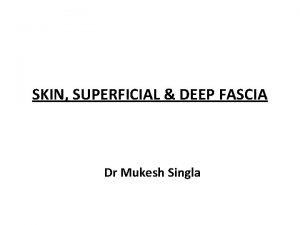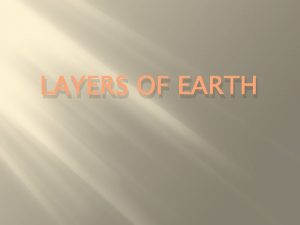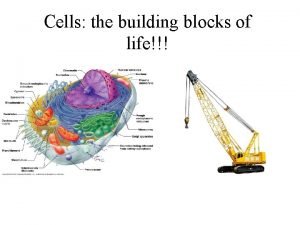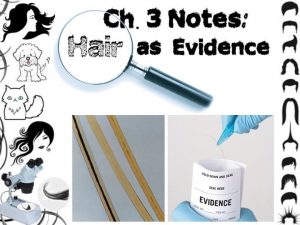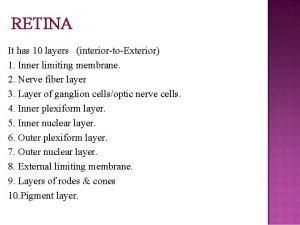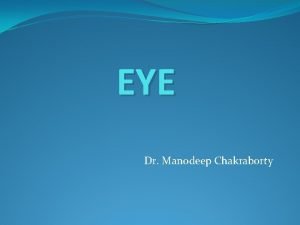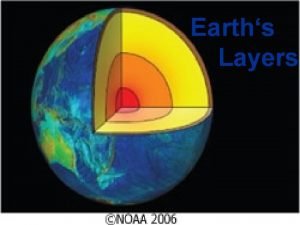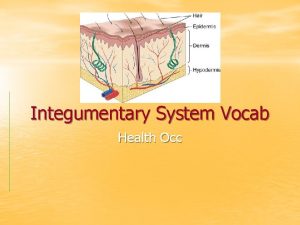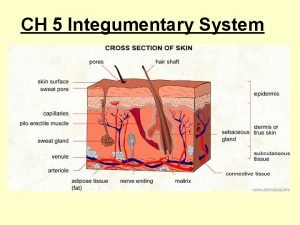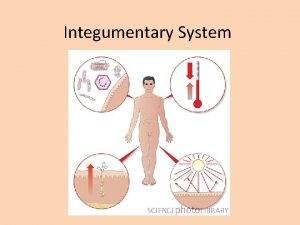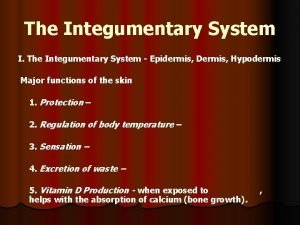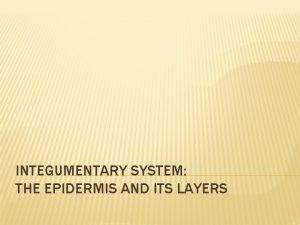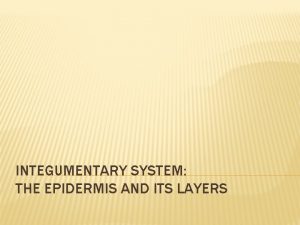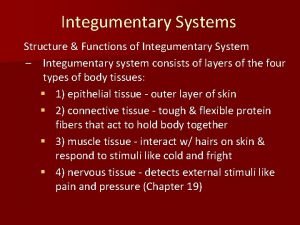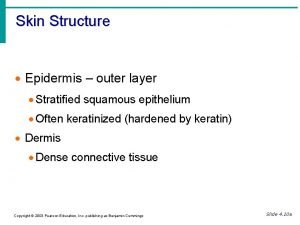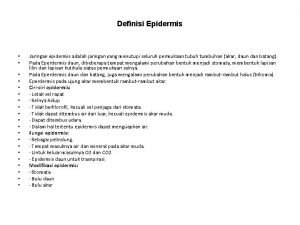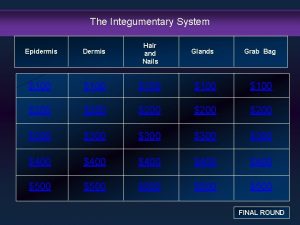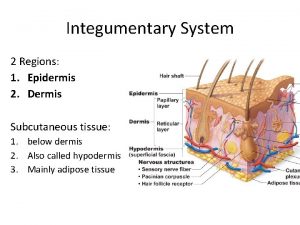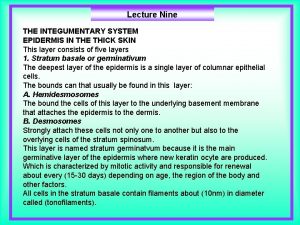Integumentary System Epidermis o o o Outer layer


























- Slides: 26

Integumentary System

Epidermis o o o Outer layer of skin Stratified squamous Has no blood supply Cells go through process of keratinization Regular skin has four strata Thick skin has five strata

Stratum basale o o o Next to basement membrane and blood supply Active mitosis Contain melanocytes

Stratum spinosum o o Consists of several layers Spiny projections extend down to connect layers together

Stratum germinativum o Composed of two layers: n Stratum basale n Stratum spinosum

Stratum granulosum o o 2 -3 layers of flattened cells Keratinization begins here

Stratum Lucidum o o Translucent 2 -3 layers Only found in thick skin

Stratum corneum o o o Outermost layer ¾ of thickness 20 -30 layers Cells are completely keratinized 5 week life cycle

Dermis

Dermis o o Stratum corium Made of dense connective tissue Papillary layer Reticular layer

Subcutaneous layer o o o Anchors skin Loose connective and adipose tissues Also called hypodermis or superficial fascia

Skin Color

Functions o o Protection Sensory reception Regulation of body temperature Synthesis of vitamin D

Epidermal Derivatives o Hair and hair follicles o Nails o Glands

Hair and hair follicles o o Composed of dead, keratinized cells Produced from stratum basale Color determined by melanin production Texture determined by shape of hair shaft

Nails o o Layers of dead stratum corneum Stratum basale forms nail bed

Glands o Three types: n Sebaceous n Sudoriferous n Ceruminous

Sebaceous glands o o o Found everywhere there is hair Holocrine glands Secrete sebum Keeps skin and hair pliable Inhibits bacterial growth and helps prevent water loss Activated by increased sex hormones

Sudoriferous glands o o o Sweat glands Located everywhere except the lips, nipples, and parts of the external genitalia Merocrine and apocrine glands

Ceruminous glands o o Modified sweat glands in the ear canal Secrete cerumen

ABCD Rule for Moles

Burns o o First degree Second degree Third degree Rule of nines

First degree burn

Second degree burn

Third degree burn

 Integumentary system the integument epidermis coloring page
Integumentary system the integument epidermis coloring page Langer lines
Langer lines What is the outer most layer of the earth
What is the outer most layer of the earth Cerebrum
Cerebrum Outer layer of the cerebrum
Outer layer of the cerebrum Structural outer layer of the basic building blocks of life
Structural outer layer of the basic building blocks of life The brittle, rocky outer layer of earth
The brittle, rocky outer layer of earth Distal tip hair
Distal tip hair Outer layer of muscle
Outer layer of muscle Outer plexiform layer
Outer plexiform layer Fibrous layer of eye
Fibrous layer of eye Optic nerve histology
Optic nerve histology What are earth's layers
What are earth's layers Fornix eye
Fornix eye Epidermis
Epidermis Integumentary system vocabulary
Integumentary system vocabulary Integumentary system pig
Integumentary system pig Integument adalah
Integument adalah Integumentary system facts
Integumentary system facts Exercise 7 the integumentary system
Exercise 7 the integumentary system Integumentary system vocab
Integumentary system vocab Integumentary system medical terminology
Integumentary system medical terminology The integumentary system
The integumentary system Integumentary system assessment
Integumentary system assessment Integumentary system analogy
Integumentary system analogy The integumentary system
The integumentary system The integumentary system
The integumentary system

